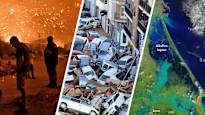A researcher from the Institute of Meteorology is humming in the Mediterranean Mika Rantanen according to the time bomb. There will be an increasing number of extreme weather events: devastating floods, droughts, forest fires and scorching heat.
Rantanen says that according to the preliminary analysis of the recently published international research group World Weather Attribution, heavy rains are about 12 percent stronger in the current climate than in a situation where climate change would not be present.
– If 200 millimeters of water rained in the area before global warming, now the amount of rain would be around 225 millimeters, which means that climate change will add several tens of millimeters.
By comparison, Valencia, Spain, received 400 millimeters of rain in eight hours on Tuesday, leading to catastrophic flooding.
The background of the heavy rains in Spain is also the so-called cold drop phenomenon. It is a stationary, very slow-moving low pressure in the upper atmosphere, which is caused by the humidity of the Mediterranean Sea, which has warmed up a lot due to the hot summer.
– Climate change does not actually create or increase these cold drop phenomena, but when one does occur, in a warmed climate the rains are stronger than they would be without climate change, says the researcher.
Flood dikes cannot withstand heavy rains
The severity of floods is increased by the fact that flood dikes have been built up to a certain threshold value. It has been thought that it is the maximum amount of rain that could fall in that area.
– Rainfall does not need to be significantly higher when flood dikes break and cause catastrophic floods, Rantanen says.
The researcher emphasizes that flooding problems occur especially in very dry areas where it rarely rains, but when it does, it can come in huge amounts at once.
At that time, the water does not soak into the soil, it starts flowing along rivers and estuaries.
– It has been predicted that the extremes of the weather will increase specifically in terms of heavy rains. When the Mediterranean has a very hot summer, there is a lot of evaporation.
– The phenomenon has been seen in recent years around the Mediterranean, for example in Libya there was a catastrophic flood last year, Rantanen reminds.
Drought fuels devastating wildfires
Rantanen says that the warming and drying of the entire Mediterranean region is in line with climate change.
Drought and heat feed and contribute to forest fires.
– Last summer was record warm in the eastern Mediterranean, and as a result forest fires raged widely in Greece.
Rantanen reminds that when the Mediterranean Sea warms up during the summer, in the fall it acts as a source of moisture and the rains get enormous energy from the warm Mediterranean Sea. This can lead to very catastrophic floods.
According to Rantanen, studies have found evidence that higher surface temperatures in the Mediterranean fuel thunderstorms that occur in the region in late summer.
– When the Mediterranean Sea is even warmer, thundercloud systems are stronger. As a result, exceptionally heavy rains occur and at the same time strong thunderstorms occur.
The warm sea waters are also associated with the disastrous water statues in the Mediterranean, which are suspected to have drowned the British billionaire by Mike Lynch yacht in Sicily in August.
In any case, the storms are intensifying in the Mediterranean.
– The so-called Mediterranean hurricanes, or medicans, are storms that get their energy from warm surface water. When the sea water is warmer than before and further into autumn, until October–November, more storms and widespread heavy rains occur in the Mediterranean.
